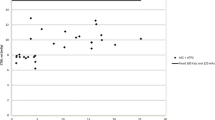Abstract
Introduction
Over the years, there has been increasing awareness of the radiation doses from medical investigation and treatment modalities and the long-term effect of this radiation. In no other patient population is this more of an issue than in the paediatric population who are more radiosensitive and have a longer life span in which to express any negative effects of radiation. In children under the age of one, the anterior fontanelle is an acoustic window to intracranial structures allowing for the use of cranial ultrasound (CRUSS) instead of CT.
Aim
To determine the pattern of CT and Cranial ultrasound used in patients aged one or younger with shunt treated hydrocephalus.
Methods
A retrospective review of patients who had a shunt inserted before the age of one and their imaging. Effective radiation doses were calculated for those who had CT scans.
Results
One hundred thirty-five patients were included with 227 CTs and 124 CRUSS conducted. In the follow-up period after shunt insertion, 92 patients had CTs while 14 were followed with CRUSS and 51 patients required a shunt revision before the age of one. The average effective radiation dose per scan was 2.76 mSv.
Conclusion
Children with an open fontanelle and shunt can be followed reliably with CRUSS in order to reduce their exposure to radiation.


Similar content being viewed by others
References
Antes S, Kiefer M, Schmitt M, Lechtenfeld M, Geipel M, Eymann R (2012) Frontal and temporal horn ratio: a valid and reliable index to determine ventricular size in paediatric hydrocephalus patients? Acta Neurochirurgica Suppliment 114:227–230
Bernier M, Rehel J, Brisse H, Wu-Zhou X, Caer-Lorho S, Jacob S, Chateil J, Aubert B, Laurier D (2012) Radiation exposure from CT in early childhood: a French large-scale multicentre study. Br J Radiol 85(1009):53–60
Berrington de Gonzalez A, Darby S (2004) Risks of cancer from diagnostic X-rays: estimates for the UK and 14 other countries. Lancet 363(9406):345–351
Bithell J, Stewart A (1975) Pre-natal radiation and childhood malignancy: a review of British data from the Oxford Survey. Br J Cancer 31(3):271–287
Brady Z, Cain T, Johnston P (2011) Paediatric CT imaging trends in Australia. Journal of Medical Imaging and Radiation Oncology 55:132–142
Brenner D (2002) Estimating cancer risks from paediatric CT: going from the qualitative to the quantitative. Pediatr Radiol 32:228–231
Brenner D, Doll R, Goodhead D, Hall E, Land C, Little J, Lubin J, Preston D, Preston R, Puskin J, Ron E, Sachs R, Samet J, Setlow R, Zaider M (2003) Cancer risks attributable to low dose of ionising radiation: assessing what we really know. Proc Natl Acad Sci U S A 100(24):13761–13766
Brenner D, Elliston C, Hall E, Berdon W (2001) Estimated risks of radiation-induced fatal cancer from paediatric CT. Am J Roentgenol 176(2):289–296
Deak P, Smal Y, Kalender W (2010) Multisection CT Protocols: sex- and age-specific conversion factors used to determine effective dose from dose-length product. Radiology 257:158–166
Dincer A, Ozek M (2011) Radiologic evaluation of paediatric hydrocephalus. Childs Nervous System 27:1543–1562
Environment ECD-Gft (2007) Radiation Protection 118- Referral Guidelines for imaging, .19 and 111
Hall E, Brenner D (2008) Cancer risks from diagnostic radiology. Br J Radiol 81(965):362–378. doi:10.1259/bjr/01948454
Holmedal L, Friberg E, Borretzen I, Olerud H, Laegreid L, Rosendahl K (2007) Radiation doses to children with shunt-treated hydrocephalus. Pediatr Radiol 37(12):1209–1215
Hounsfield G (1973) Computerized transverse axial scanning (tomography): Part 1. Description of system British Journal of Radiology 46:1016–1022
Hsu C, Lee K, Jeng M, Chang K, Yang C, Tsao P, Lee Y, Chen S, Soong W, Tang R (2012) Cranial ultrasonoraphic findings in healthy full-term neonates: a retrospective review. Journal of the Chinese Medical Association 75(8):389–395
Kielser J, Ricer R (2003) The abnormal fontanel. Am Fam Physician 67(12):2547–2552
Lowe L, Bailey Z (2011) State-of-the-art cranial sonography: part 1, modern techniques and image interpretation. Am J Roentgenol 196(5):1028–1033
Pearce M (2011) Patterns in paediatric CT use: an international and epidemiological perspective. Journal of Medical Imaging and Radiation Oncology 55:107–109
Pearce M, Salotti J, Little M, McHugh K, Lee C, Kim K, Howe N, Ronckers C, Rajaraman P, Craft A, Parker L, Berrington de Gonzalez A (2012) Radiation exposure from ct scns in childhood and subsequent risk of leukaemia and brain tumours: a retrospective cohort study. Lancet 380:499–505
Preston D, Ron E, Tokuoka S, Funamoto S, Nishi N, Soda M, Mabuchi K, Kodama K (2007) Solid cancer incidence in atomic bomb survivors: 1958–1998. Radiat Res 168(1):1–64
Protection ICoR (2007) The 2007 Recommendations of the International Commission on Radiological Protection: ICRP Publication 103. Annals of the International Commission on Radiation Protection 37(2–4):1–332
VII B (2006) Health risks from exposure to low levels of ionizing radiation: BEIR VII- Phase 2 committee to assess health risks from exposure to low levels of ionizing radiation, National Research Council, The national academies pressWashington:1–424
Wakhlu A, Ansari N (2004) The prediction of postoperative hydrocephalus in patients with spina bifida. Childs Nervous System 20:104–106
Author information
Authors and Affiliations
Corresponding author
Rights and permissions
About this article
Cite this article
Mandiwanza, T., Saidlear, C., Caird, J. et al. The open fontanelle: a window to less radiation. Childs Nerv Syst 29, 1177–1181 (2013). https://doi.org/10.1007/s00381-013-2073-0
Received:
Accepted:
Published:
Issue Date:
DOI: https://doi.org/10.1007/s00381-013-2073-0




